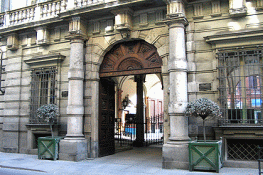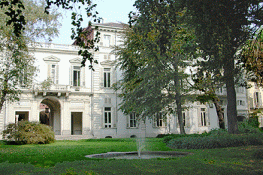Currently, the palace is located in the old 'Assunta' block bounded by several streets: Bogino, Giolitti, Carlo Alberto and Maria Vittoria. The original core of the building - owned by Count Flaminio Antonio Ripa di Giaglione - dates back to 1675. The current garden area was added three years later at the request of the Royal Mistress.
In 1685 the building was handed over by the Dal Pozzo della Cisterna family, who progressively enriched and decorated the structure. Several works of renovation and extension, which were designed by the royal architect Francesco Valeriano Dellala of Beinasco, began in the second half of the 18th century and were completed under the prince-patron Giuseppe Alfonso; therefore the west wing was reshaped and the facade was redesigned, and stables were built. Skilled artisans and craftsmen carried out decorations in wood, plaster and iron.
The palace is a good example of Piedmontese Baroque mixed with neoclassicism, especially in the interiors.
Then followed a period of interruption of the decoration activities, which only restarted in the second half of the 19th century when Maria Vittoria, daughter of Carlo Emanuele della Cisterna, and Amedeo di Savoia, Duke of Aosta, married.
The palace became a prestigious and opulent house: new rooms were added, coffered ceilings were made, cathedral stained-glass windows were placed, gold plating and silk tapestries were applied.
After the death of Princess Maria Vittoria, at the behest of her husband Amedeo d'Aosta, work on the palace continued. It was then approved the project for the construction of the gate around the garden on Via Carlo Alberto (which replaced the old boundary wall) and the project for the reconstruction of the Scalone d'Onore.
Technological improvements also belong to this time, such as the gas lighting in the entrance, and the raising of the terrace between the main courtyard and the garden. In the first half of the 20th century, only minor interventions were carried out; in 1940, the Savoy-Aosta family sells the barely used building to the Provincial Administration, making it its official seat in 1945.
The Province of Turin thereby took up residence in 'a decorous location that met its needs' and at the same time also ensured 'the custody of a palace that recalls memories dear to any Italian citizen's heart, especially that of every Piedmontese'.
Over the years, the palace was restored and adapted for public purposes, always respecting its historical value.


